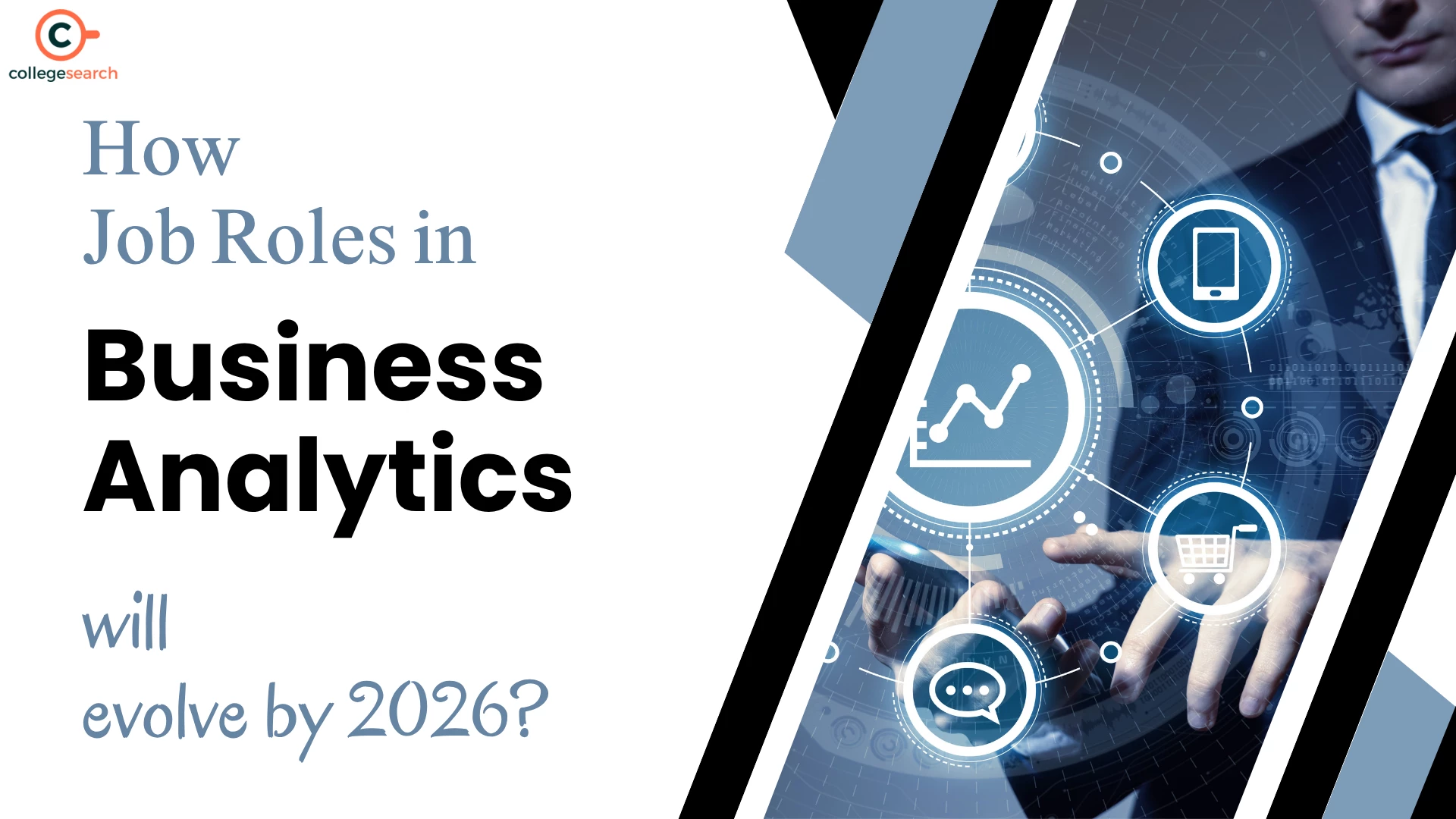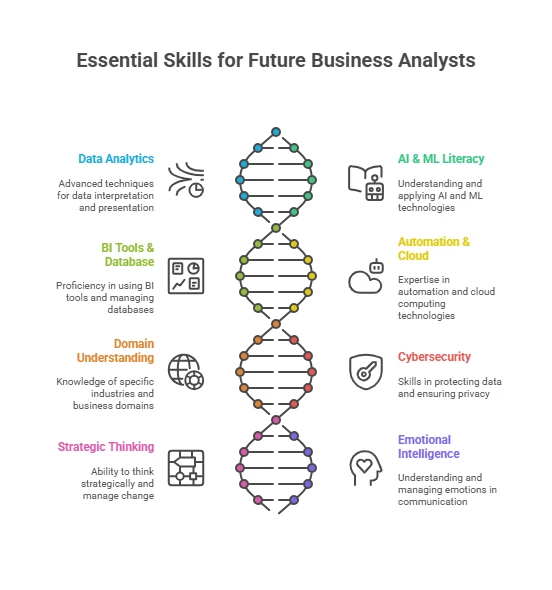The Job Roles of Business Analytics are expected to grow, and thus, it can have a direct impact on the salary structure and career progression for an MBA graduate by 2026. The scope of analytics roles will grow beyond those previously held by traditional data or business analysts as more organizations across industries adopt data-driven strategies.
Specialized or hybrid roles will be the norm by 2026. Data Scientist, AI Business Analyst, Machine Learning Engineer, and Chief Data Officer (CDO) are some of the key titles that will be omnipresent across top companies. The advanced skills in artificial intelligence, machine learning, data governance, and cloud-based analytics that these roles require all come with high salary premiums.

Companies are expected to pay employees in Business Intelligence (BI) who have AI and cloud analytics skills up to 30 % more than their traditional counterparts, offering them lucrative salaries with predictive and automated analytics taking shape across all organizations.
In addition, AI-powered tools and increasing telecommuting will change the landscape of employment needs. Analysts will evolve from mere reporting and dashboards to becoming the engine that drives real-time, prescriptive insights for business leadership. This evolution will take positions like Product Analytics Manager, Risk Analytics Lead, or Analytics Consultant to significantly more senior roles and higher pay scales.
Roles like Data Analyst and Business Analyst, which are mostly entry-level roles, provide mean salaries around 8-12 LPA will start to demand modern analytic tools capability in addition to soft skills for cross-functional collaboration. As experience kicks in, the growth spurt becomes dreamy and salaries like 15–20 LPA at mid-level roles (BI Analyst, Data Engineer, Marketing Analytics Manager) to >35 LPA for senior or leadership roles will not be a distant dream anymore.
Significantly, based on market research and industry standing, it is also anticipated that the analytics jobs in India are only set to increase at a 14% CAGR till 2026. Business analytics schools feed out some of the best in the industry and Tier-1 MBA colleges e.g., IIMS expect their analytics grads to command an average salary in the range ₹32–37 LPA that works out a compound annual increase of 8–12% as Business Analytics skills are only going to rise as we move more towards data-centric economy. Investors in newly emergent fields of expertise, as well as those with certifications or direct project experience (ex, AI, cloud analytics, industry-specific analytics such as financial services/ healthcare/ supply chain) will secure the highest-paying positions.
So overall, as analytics job roles become more specialized, strategic, and technology-driven by 2026, MBA Business Analytics graduates can expect not just broader career opportunities but also considerable salary growth, with top performers achieving industry-leading compensation.
How will the role of business analysts change by 2026?
Ten years from now, the business analyst is expected to be in a much more strategic and highly technological world role, providing analytical inputs for decision-making. Business analysts also recognised they must improve on their traditional tasks, where requirements gathering and process mapping were a minimum foundation for upcoming responsibilities in key areas such as.
- Integration of AI and Advanced Analytics: Business Analysts will make more use of Artificial Intelligence, Automation, and Predictive Model Development to derive business value. Deploying the latest-and-greatest tools not only to mine through historical data but also to model trends, assess risks, and submit real-time, analytical solutions. Repeatable tasks like data collection and reporting will be automated so analysts can spend time making sense of strategy, recommending actions.
- Increased and Hybrid Roles: The distinction between a business analyst, data analyst, and product owner will be increasingly blurred. Roles will often morph into a hybrid mixture of digital transformation, product management, and cybersecurity across different use cases, falling in between more technical teams on one side and business stakeholders on the other. Agile and cross-functional teams are becoming more common, transforming the business analyst role to define products for user stories in line with both user needs and business objectives.
- Strategic Effect: Through ongoing presence in the business strategy processes, analysts will partner with leadership to define and implement market strategies, resource optimization, and change enablement. Their objective changes to providing visioning for long-term prospective faculty as well as enabling businesses to change direction rapidly in changing market conditions.
- Collaboration and Communication: Using a common language to share technical processes in everyday terms with stakeholders will help organizations meet their partners halfway. They will be taking more of a role in change management and continuous improvement by making sure that new systems or processes align with what the business wants.
While automation will handle much of the heavy lifting, there will always be some uniquely human elements required in the business analyst, particularly complex problem-solving, ethical considerations, and stakeholder relationships. Therefore, the requirement for business analysts in India is expected to increase around 14% by 2026 and at a proficient rate on consistent improvement of individual technical, analytical, and overall business acumen.
What skills will you be required for an MBA in Business Analytics in 2026?
The MBA in Business Analytics has evolved from merely gathering requirements to playing a strategic role in optimization and fostering innovation. Consequently, the demand for business analysts is at an all-time high. For instance, the Bureau of Labor Statistics forecasts a 23% growth in Operations Research Analyst positions from 2023 to 2033.
These experts play a crucial role in connecting business objectives with technological solutions, helping organizations make well-informed decisions through data-driven insights.
- Advanced Data Analytics and Visualization – A working knowledge of data analytics tools such as SQL, Python, R, Tableau, and Power BI will be imperative to analyze large datasets, form predictive models, and convey actionable intelligence.
- Literacy for Artificial Intelligence (AI) and Machine Learning (ML): Business analysts must understand the flow of AI/ML—in other words, how automated analytics or predictive analytics take inputs and yield outputs, used as input to decisions.
- Business Intelligence (BI) Tools & Database Management: Proficiency in BI platforms, relational databases(RDBMS -SQL, Oracle, MySQL), and also NoSQL solutions to manage/query/unlock value from large enterprise data.
- Cloud Computing Automation and Tools: Being able to evaluate business processes for automation (RPA, workflow tools) and experience with cloud computing & hybrid cloud environments would be an added advantage.
- Domain and Industry Understanding – However, with the emerging industry demand towards areas such as ESG (environmental, social, and governance), regulatory compliance, and digital marketing analytics, sector-specific analytics will drive more domain-centric business expertise.
- Security and Data Privacy: As organizations are now working with more sensitive data at a larger scale, expect to see the need for some basic common knowledge regarding security basics, responsible AI/analytics governance based on a line with regulatory requirements for data privacy.
- Strategic Thinking & Change Management: Analysts will be asked to provide strategic recommendations, lead process optimization initiatives, and execute on organizational change. Experience in strategic planning, risk assessment, and stakeholder management.
- Emotional Intelligence and Communication: Interpersonal skills like effective communication, cross-functional teams collaboration, negotiation, and high emotional intelligence will be as invincible as technical skills since analysts are bridging the gap between techies & business users.







































.png)

.png)









